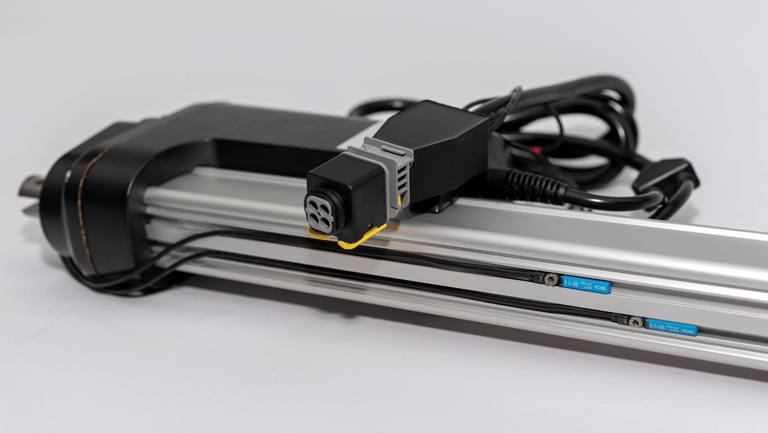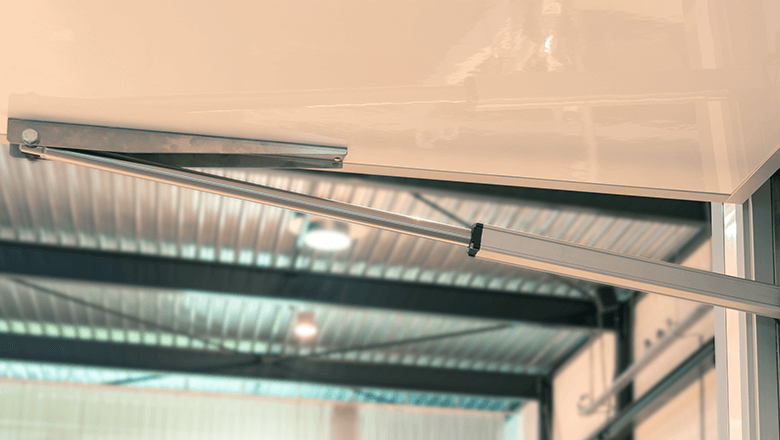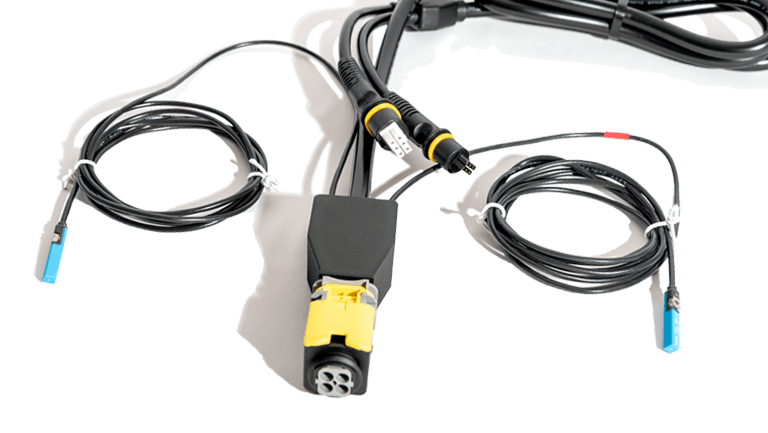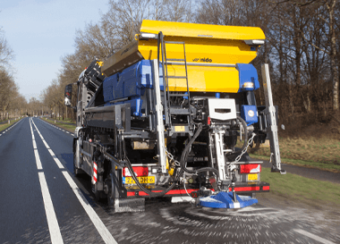Magnetic sensor makes for simple adjustment of linear actuator stroke length

Thanks to integrated magnetic sensors, LINAK’s linear actuators are now easy to adjust. This allows end users to adapt the stroke length of standard actuators to their specific applications, without having to program settings. There is a great need for various stroke lengths, especially in areas where unique applications are the rule rather than the exception. Sensor integration provides a universal solution.
Sentech has developed a magnetic sensor assembly that allows the end user to set the stroke length of the linear actuator. Find out how we worked together to integrate this sensor solution.
How do you integrate a magnetic sensor in a linear actuator?
The linear actuators from LINAK enable smooth push and pull movements. Such drives can be found in diverse applications, from agricultural machinery to adjustable furniture and industrial automation.
LINAK was looking for a way to integrate a magnetic sensor into its linear actuator so end users could set the stroke length themselves, without modifying the software. Many of LINAK’s customers manufacture custom products, where the stroke length must be adapted to the application.
Henk Lafeber, Account Manager at LINAK, explains. “Every application differs in size, which results in different stroke length requirements. Settings are then required to achieve the right stroke length. How do we provide a solution without pre-programming? In many areas, it’s difficult to determine in advance which precise lengths will be necessary. We wanted to offer a universal product that is adjustable during the implementation of the actuator.”
Collaboration for sustainable sensor integration
Lafeber explains that there was already a link between LINAK and Sentech. “We used to sit at the same table during network evenings. We felt that a sensor could be a solution, so it was a logical step to engage Sentech’s help.”
LINAK already had an idea about how it could solve this problem and created its own prototype. It then approached Sentech with this concrete idea.
“Our prototype was a good start, but it didn’t satisfy all the requirements. Marie-Jose Wolters, Account Manager at Sentech, posed some critical questions, such as: ‘Does the product need to be waterproof or water-resistant? What IP values does it need? What currents run through the wires?’ We hadn’t thought extensively about these issues,” says Lafeber.

Integration of magnetic sensors on the spindle of an actuator: Now the end user can set the stroke length of the actuator.
Magnetic sensor: logical choice of technology
It was no surprise that this technology was selected for this application. When the actuator was developed, future needs were already taken into account. For example, the nut on the spindle was fitted with a magnet.
“When the magnet reaches the sensor, switching takes place. The motor no longer receives a control signal, and the actuator remains in the same mode,” explains Wolters.
Important quality requirements of the sensor solution
The project was quickly confronted by other challenges. How do we make sure that the magnetic sensor, along with the actuator, can be easily integrated by the end user? And that it’s waterproof?
Based on the quality requirements, Wolters looked for a connector. “Eventually, we proposed a future-proof connector that met the specifications. The prototype developed by LINAK had six or seven conductors; we reduced the number to four. Their design also had double contractions, which is terrible if you want to make a product waterproof. Using the prototype as a starting point, we designed a solution that satisfies all the requirements.”
The final product, the magnetic sensor assembly, had to be easy to integrate on the actuator. The solution was designed in a way that allows end users to connect the actuator to the sensor assembly.
Listening to the needs of the end user
Halfway through this process, another requirement arose. Besides an assembly with one sensor, LINAK also wanted an assembly with two sensors. As Lafeber, LINAK’s Account Manager, recalls, “When we put the actuator with one sensor to use in the field, we discovered there was also a need for an actuator with two sensors. A single sensor only allows you to set the outgoing movement. If the user also wants to set the incoming movement, you need a second sensor.”
He continued, “This is certainly valuable for applications in the market vehicle segment, which builds custom models rather than series. This means you need an actuator with a different stroke length for each situation. Now the builder can modify the actuator on the vehicle.”
Creative engineering process
A waterproof housing had already been developed for the magnetic sensor assembly with one sensor. The die for producing the overmold was also available.
“Thanks to the creativity and flexibility of our engineers, we were able to find an efficient solution to the problem. We used the same die to make the housing for the assembly with two sensors by adding an insert. This was more economical than producing a second die. We also simplified the product. That’s why it’s always good to have a project engineer brainstorming on the project,” explains Sentech Account Manager Wolters.

Magnetic sensor assembly with two magnetic sensors: The second sensor allows both the actuator’s incoming and outgoing movements to be set.
Monitoring quality through project management
In this sensor integration project, Sentech followed its work processes. Sentech is therefore certain that a future sensor assembly will have the same level of quality as the first assembly.
“The entire process – from the development assignment to the first production series – took five months. Such a turnaround time is necessary to go through all the process steps and respect our working methods. We identify risks and safeguard quality,” explains Wolters.
Lafeber adds, “Over the course of a year, we’ve gone from a complicated solution to a simple solution. That’s the greatest added value that Sentech brings. In the end, we have a good product that we can use to assist customers in sectors as diverse as agricultural machinery, market vehicles and yachts.”
Innovative sensor solution: an adjustable standard product
To ensure that a linear actuator has the proper stroke length in numerous applications, only two types of magnetic sensor assemblies are now required. LINAK’s actuators are standard products. With this innovative sensor solution, customers can set the drives themselves.
“We supply two separate motors that differ in integration size and maximum stroke length. The integration size needed by the customer determines the choice of motor. The vehicle builder or user then adjusts the stroke length themselves. That’s how I serve a large group of customers with one standard product,” says Lafeber.
Adjust stroke length at any time
Even after integration, the end user can easily adjust the stroke length. One example is an actuator in a mower, where the farmer can set the mowing height himself.
Setting the stroke length is simple – the user simply slides the sensors in the actuator. Lafeber adds, “The assemblies with sensors are also sold separately, so that end users can integrate these in their actuators at a later date.”
This is how you integrate successful sensor technology!
Integrating successful sensor technology is not without its challenges. How do you prepare yourself for environmental factors that you’re not yet aware of? And which sensor trends can you, as an engineer, expect to see in the future?
You’ll find the answers to these questions in our free e-book, including practical examples of many common sensor issues and solutions.
Get some inspiration, and download this free e-book now.





